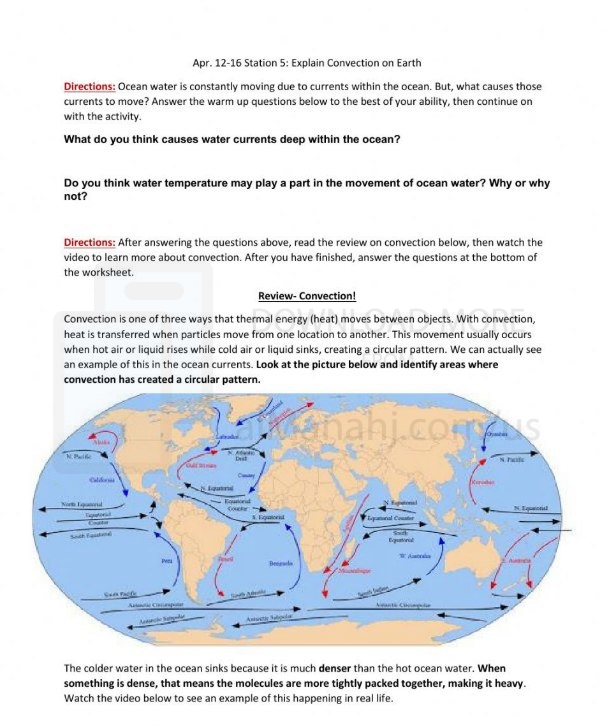| You are here: Almanahj Website ⇒ American curriculum ⇒ 6th Grade ⇒ Geology ⇒ Term 1 | ||
|---|---|---|
Worksheet about Convection on Earth | ||
|---|---|---|
| Subject: Geology | ||
| 6th Grade | ||
| Term 1 | ||
| Year: 2023/2024 | ||
| Size: 255.2KB | ||
| Number of clicks: 165 | ||
| Publish date:November 22, 2023 | ||
| Added by: Eman | ||
| Last download date: 2024-09-13 13:08:24 | ||
| Updated by: Eman9966 on 2023-11-23 16:01:19 | By: theodor taylorpe | |
| File info: Convection is a fundamental heat transfer process that plays a crucial role in shaping Earth's interior dynamics and influencing various geological processes. It involves the large-scale movement of fluid or gas due to differences in temperature and density. Convection in Earth's Mantle The most prominent example of convection on Earth occurs within the mantle, the layer between the Earth's crust and core. The mantle is composed of hot, molten rock known as magma, which is constantly heated from the Earth's core and cooled from below the crust. This temperature difference drives the movement of magma in a continuous cycle of uplift, cooling, and descent. Mantle Plumes and Plate Tectonics Hot plumes of mantle material rise through the cooler surrounding mantle, forming mushroom-shaped structures known as mantle plumes. These plumes release heat and material, contributing to volcanic activity and upwelling of the Earth's crust. The movement of the mantle due to convection is the driving force behind plate tectonics, the large-scale movement of Earth's tectonic plates. As the mantle plates move, they interact with each other, causing earthquakes, volcanic eruptions, and the formation of mountains and ocean basins. Convection in the Atmosphere and Oceans Convection also occurs in Earth's atmosphere and oceans, influencing weather patterns and ocean circulation. In the atmosphere, warm air rises and cool air sinks, creating updrafts and downdrafts that drive wind and cloud formation. In the oceans, convection currents transport heat and nutrients throughout the water column, influencing marine ecosystems. Impacts of Convection Convection plays a significant role in various geological processes, including: Plate tectonics: The movement of tectonic plates, driven by mantle convection, shapes the Earth's surface and forms continents, mountains, and ocean basins. Volcanism: Mantle plumes and convection currents contribute to volcanic activity, releasing heat and material onto the Earth's surface. Weather patterns: Convection in the atmosphere drives wind patterns and cloud formation, influencing weather systems. Ocean circulation: Convection currents in the oceans transport heat and nutrients, affecting marine ecosystems and influencing global climate patterns. Understanding convection is crucial for comprehending Earth's interior dynamics, predicting geological events, and managing natural disasters. By studying convection currents, scientists gain insights into the Earth's past, present, and future, enabling us to better understand our planet and its processes. | ||
| Downloading link Worksheet about Convection on Earth |
|---|
|
1700651263.pdf
The file is being prepared for download
|
| File images |
|---|
 |